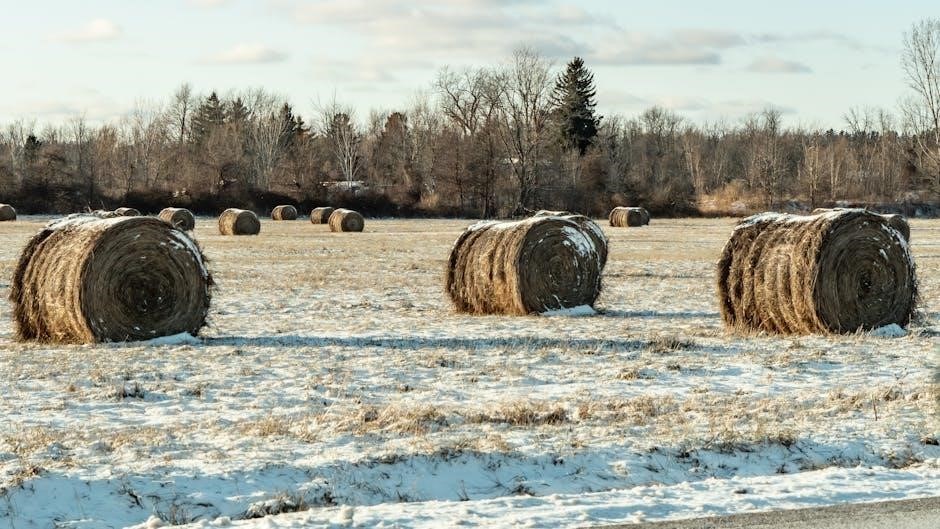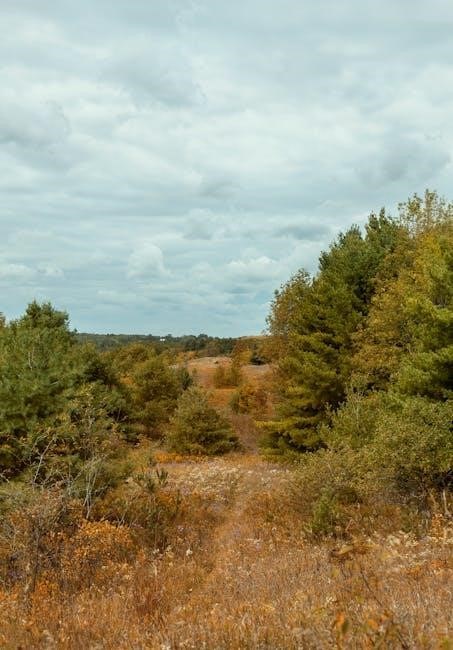Ontario’s diverse landscape hosts over 100 native tree species, ranging from towering conifers to vibrant deciduous trees. This field guide, featuring over 1,400 photographs, helps identify and explore Ontario’s arboreal richness, perfect for nature enthusiasts and researchers alike. Discover the province’s forest ecosystems through detailed descriptions and visual aids, making tree identification accessible and engaging for all skill levels. Whether hiking in the woods or strolling through urban parks, this guide is an essential companion for understanding Ontario’s tree species and their significance.
Overview of Tree Diversity in Ontario
Ontario boasts an impressive diversity of tree species, with over 100 native varieties thriving across its vast landscapes. From the iconic sugar maple to the towering eastern white pine, the province’s forests are a mosaic of deciduous and coniferous trees. This diversity is supported by Ontario’s varied climate and geography, ranging from the boreal north to the temperate south. The region’s tree species play vital ecological roles, providing habitat for wildlife and contributing to the province’s natural beauty. This guide explores the rich arboreal heritage of Ontario, highlighting key species and their unique characteristics.
Importance of a Field Guide for Tree Identification
A field guide is an essential tool for accurately identifying Ontario’s tree species, offering detailed descriptions, vibrant images, and diagnostic features. It helps enthusiasts and researchers distinguish between similar species, understand habitats, and appreciate ecological roles. With over 1,400 photographs, this guide bridges the gap between observation and knowledge, making tree identification accessible to all skill levels. It fosters a deeper connection with nature, supports conservation efforts, and inspires stewardship of Ontario’s diverse forests and urban landscapes.

Key Characteristics for Tree Identification
Identifying Ontario’s trees involves examining leaves, bark, flowers, fruits, and cones. These features provide essential clues for accurate species recognition, enhancing understanding and appreciation of local flora.
Leaf Identification: Shapes, Sizes, and Arrangements
Leaves are crucial for identifying Ontario’s trees, with shapes ranging from ovate to lanceolate and sizes varying from small to broad. Arrangements like alternate, opposite, or whorled patterns provide diagnostic clues. For example, sugar maple leaves are broad and palmate, while eastern hemlock leaves are short and needle-like. Red oak leaves feature deep lobes, and silver birch leaves are small and oval. Observing these traits helps distinguish species effectively, making leaf identification a foundational skill for tree enthusiasts.
Bark and Stem Features: Texture and Color
Bark and stem characteristics are essential for identifying Ontario’s trees, offering unique textures and colors. Smooth bark, like that of young beech trees, contrasts with the scaly, fissured bark of older oaks. Paper birch exhibits white, papery bark, while red maple often shows gray ridges. Color variations, such as the striped patterns on striped maple stems, further aid identification. Seasonal changes and tree age influence these features, making them valuable diagnostic tools. Vibrant photographs in field guides help illustrate these details, ensuring accurate recognition of Ontario’s diverse tree species.
Flowers, Fruits, and Cones: Diagnostic Features
Flowers, fruits, and cones are key diagnostic features for identifying Ontario’s trees. Conifers produce cones, with pines having large, woody ones and firs displaying smaller, upright styles. Deciduous trees like birches and willows often bear catkins. Fruits vary widely, from the acorns of oaks to the winged samaras of maples. Seasonal changes enhance these features, making them vital for accurate identification. Field guides use detailed images to highlight these structures, ensuring enthusiasts can distinguish species effectively. These reproductive features are indispensable in the study and appreciation of Ontario’s arboreal diversity.

Native Trees of Ontario
Ontario’s native trees showcase a rich diversity, from towering pines to vibrant maples. These species have thrived for centuries, shaping ecosystems and cultural heritage across the province. Indigenous communities have long relied on them for resources, while modern conservation efforts prioritize their protection and sustainable use. Native trees form the backbone of Ontario’s forests, providing habitat and sustenance for countless wildlife species. Their resilience and adaptability highlight their vital role in the province’s environmental and historical identity.
Deciduous Trees: Oaks, Maples, and Birches
Deciduous trees like oaks, maples, and birches are iconic in Ontario, known for their vibrant autumn colors and ecological significance. Oaks, such as the white oak and red oak, are valued for their strength and acorns, which support wildlife. Maples, including the sugar maple, are celebrated for their sap and striking foliage. Birches, like the paper birch, are recognized for their distinctive bark and adaptability. These genera represent a diverse and vital part of Ontario’s native tree population, providing habitat and sustenance for countless species while enriching the province’s natural beauty and cultural heritage.
Coniferous Trees: Pines, Spruces, and Firs
Coniferous trees like pines, spruces, and firs dominate Ontario’s landscapes, offering year-round greenery. Pines, such as the Eastern White Pine and Red Pine, are distinguished by their needle clusters and large cones. Spruces, including Black Spruce and White Spruce, feature sharp, singular needles and small, pendant cones. Firs, like the Balsam Fir, are recognized by their soft needles and upright cones. These evergreens thrive in diverse habitats, from boreal forests to urban settings, playing a crucial role in Ontario’s ecosystems, forestry, and even the Christmas tree industry, with their needles often persisting for up to five years.
Less Common Native Species: Rare and Endangered Trees
Ontario is home to several rare and endangered tree species, such as the Butternut and Red Mulberry, which are threatened by habitat loss and disease. The Eastern Flowering Dogwood, though not native, is also rare in the province. These trees often inhabit specific niches, like floodplains or limestone regions, and are vital for biodiversity. Conservation efforts focus on protecting these species through controlled planting and habitat restoration. Awareness of their unique characteristics and threats is crucial for their survival, making them a priority in Ontario’s ecological preservation initiatives.
Non-Native and Invasive Tree Species
Non-native tree species, introduced by human activity, often outcompete native plants, disrupting ecosystems. Invasive trees like the Tree-of-Heaven spread aggressively, posing ecological and economic challenges to Ontario’s forests and habitats.
Common Invasive Trees in Ontario
Ontario faces significant threats from invasive tree species, such as the Tree-of-Heaven (Ailanthus altissima) and Emerald Ash Borer (Agrilus planipennis), which devastate native ash trees. Other invaders include the Norway Maple (Acer platanoides) and Common Buckthorn (Rhamnus cathartica), both of which outcompete native vegetation. These species often spread rapidly, altering ecosystems and reducing biodiversity. Early identification and management are crucial to mitigate their impact on Ontario’s forests and urban landscapes.
Impact of Invasive Species on Ecosystems
Invasive tree species disrupt Ontario’s ecosystems by outcompeting native vegetation, altering habitats, and reducing biodiversity. They often spread aggressively, forming dense stands that shade out native plants and disrupt nutrient cycles. Invasive insects, like the Emerald Ash Borer, have devastated ash tree populations, while species such as the Tree-of-Heaven degrade soil quality and harm wildlife habitats. These invasions can irreparably alter forest compositions, threatening endangered species and weakening ecosystem resilience. Early detection and management are critical to mitigating their long-term ecological consequences and protecting Ontario’s natural heritage.

Tree Habitats and Regions in Ontario
Ontario’s diverse geography supports a wide range of tree habitats, from northern boreal forests to southern deciduous woodlands. This field guide explores the unique tree species thriving in each region, helping readers identify and appreciate the province’s rich arboreal diversity.
Forest Types: Boreal, Temperate, and Mixed Forests
Ontario’s forests are classified into three main types: boreal, temperate, and mixed. Boreal forests dominate the north, featuring conifers like black spruce and balsam fir. Temperate forests in the south are home to deciduous species such as sugar maple and oak. Mixed forests, found in central regions, blend coniferous and deciduous trees, creating diverse ecosystems. These forest types support a wide range of biodiversity and play a crucial role in Ontario’s ecological balance, offering habitats for wildlife and contributing to the province’s natural beauty.
Regional Variations: Northern, Central, and Southern Ontario
Ontario’s tree species vary significantly across its northern, central, and southern regions. Northern Ontario is dominated by boreal forests, with species like black spruce and jack pine thriving in cooler climates. Central Ontario features a mix of boreal and temperate species, including eastern white pine and red maple. Southern Ontario, with its milder climate, is home to deciduous trees such as sugar maple and American beech. These regional differences reflect diverse ecological conditions, creating a rich tapestry of tree species across the province;
Urban and Cultivated Trees
Urban and cultivated trees in Ontario include species like maple, oak, and linden, chosen for resilience and beauty. These trees enhance cityscapes, providing shade and improving air quality while adapting to urban challenges.
Popular Tree Species for Urban Landscapes
Popular urban tree species in Ontario include the sugar maple, red oak, and littleleaf linden, chosen for their resilience and aesthetic appeal. These trees thrive in urban environments, providing shade and enhancing cityscapes. Species like the crabapple and honey locust are also favored for their vibrant flowers and structural beauty. Urban trees play a crucial role in improving air quality, reducing noise pollution, and creating welcoming green spaces. Their adaptability to urban conditions makes them ideal for landscaping projects across Ontario.
Challenges of Urban Tree Planting and Maintenance
Urban tree planting and maintenance face challenges such as soil compaction, limited space, and exposure to road salt. These conditions can hinder tree growth and health. Additionally, invasive species and pests often threaten urban trees, requiring constant monitoring. Climate change exacerbates these issues, making tree survival more difficult. Proper care, including regular watering and pruning, is essential but can be resource-intensive. Despite these challenges, urban trees remain vital for improving air quality, mitigating heat islands, and enhancing city aesthetics, making their care a worthwhile investment.

Conservation and Sustainability
Conservation and sustainability are crucial for preserving Ontario’s diverse tree species and ecosystems. Efforts include protecting forests, promoting eco-friendly practices, and raising awareness about environmental stewardship.
Efforts to Protect and Restore Ontario’s Forests
Ontario’s forests are protected through reforestation programs, conservation initiatives, and sustainable forestry practices. Organizations collaborate with Indigenous communities to restore habitats and promote biodiversity. Efforts focus on preserving old-growth forests and combating invasive species. Community involvement and educational programs raise awareness about forest conservation. These initiatives ensure the long-term health of Ontario’s ecosystems, benefiting both wildlife and future generations. Sustainable practices are key to maintaining the province’s rich arboreal heritage.
Sustainable Practices for Tree Planting and Management
Sustainable tree planting and management involve selecting native species, preparing soil properly, and ensuring adequate spacing. Practices include water conservation, mulching, and avoiding harmful pesticides. Regular monitoring and pruning maintain tree health and structural integrity. Community engagement and educational programs promote sustainable forestry. Certification programs recognize responsible practices, ensuring long-term ecosystem benefits. These methods support biodiversity, mitigate climate change, and preserve Ontario’s forests for future generations while fostering a balance between human needs and environmental stewardship.

Visual Identification Aids
Photographs and illustrations are crucial for accurate tree identification, showcasing leaf shapes, bark textures, and fruit characteristics. Comparison charts highlight differences between similar species, aiding precise recognition.
Photographs and Illustrations for Accurate Identification
High-quality photographs and detailed illustrations are essential for identifying Ontario’s tree species. The field guide features over 1,400 vibrant images, showcasing key characteristics such as leaf shapes, bark textures, and fruit types. These visuals aid in distinguishing similar species, providing clear comparisons. Illustrations highlight specific features like leaf arrangements and cone structures, while photographs capture the natural appearance of trees in various seasons. This combination of visual elements ensures accurate identification, making the guide invaluable for both beginners and experienced naturalists exploring Ontario’s diverse tree species.
Comparison Charts for Similar Tree Species
Comparison charts are invaluable for distinguishing between Ontario’s tree species that share similar characteristics. These charts highlight differences in leaf shapes, bark textures, and fruit types, aiding accurate identification. By visually contrasting features like needle length, cone structure, and leaf arrangements, the charts help users quickly differentiate species. This tool is particularly useful for beginners and experts alike, ensuring efficient and precise identification. The guide’s charts are designed to simplify complex comparisons, making tree identification more accessible and reliable for all users exploring Ontario’s diverse tree species.
Interactive Tools and Resources
Interactive tools like mobile apps and online databases enhance tree identification, offering dynamic ways to engage with Ontario’s tree species, fostering learning and community among enthusiasts.
Mobile Apps for Tree Identification
Mobile apps like Leafsnap and iNaturalist revolutionize tree identification, offering visual search and species databases. Users can upload photos or descriptions, receiving instant matches. These apps often include detailed factsheets, images, and location data, making them invaluable for enthusiasts and researchers. They enable real-time learning in the field or urban settings, fostering a deeper connection with Ontario’s tree species. By leveraging technology, these tools simplify identification and promote environmental education, making them essential companions for anyone exploring Ontario’s arboreal diversity.
Online Databases and Forums for Tree Enthusiasts
Online databases and forums provide invaluable resources for tree enthusiasts, offering detailed species information, discussion platforms, and community-driven insights. Platforms like Ontario’s Tree Atlas and specialized forums allow users to share observations, seek expert advice, and learn from others’ experiences. These tools foster collaboration and knowledge exchange, enabling enthusiasts to deepen their understanding of Ontario’s tree species. They also serve as hubs for updates on rare or invasive species, making them essential for both casual learners and dedicated researchers.
Historical and Cultural Significance
Trees in Ontario hold deep cultural and historical importance, featuring prominently in Indigenous traditions, early settler economies, and as enduring symbols of natural heritage and community identity.
Indigenous Uses of Ontario’s Trees
Ontario’s Indigenous communities have long relied on native trees for food, medicine, tools, and cultural practices. Species like birch and maple were crucial for survival, providing materials for canoes, baskets, and syrup production. Trees also played spiritual roles in ceremonies and storytelling, reflecting their deep connection to the land.
The sustainable use of trees by Indigenous peoples highlights their profound understanding of nature. From cedar for smudging to pine for resin, each species holds specific significance, emphasizing a harmonious relationship with the environment that continues to inspire modern ecological practices.
Historical Role of Trees in Ontario’s Economy
Trees have been a cornerstone of Ontario’s economy since colonization. The logging and woodworking industries flourished, with species like pine and oak being highly valued. The fur trade also relied on forests for resources. Sawmills and paper production became key sectors, driving provincial growth. Trees additionally supported shipbuilding and construction, shaping Ontario’s industrial foundation. This historical reliance on forests laid the groundwork for the province’s economic development, illustrating the enduring importance of trees in shaping Ontario’s identity and prosperity.

Practical Uses of Trees
Trees provide timber, food, and medicinal products, supporting industries and communities. Ontario’s species like maple offer syrup, while others supply wood for construction and furniture, sustaining economies and livelihoods.
Timber, Food, and Medicinal Uses of Ontario Trees
Ontario’s trees provide essential resources, from timber for construction and furniture to food like maple syrup, a staple derived from sugar maple trees. Medicinal properties are also harnessed, such as birch for salicin and willow for pain relief. These uses highlight the economic and ecological value of Ontario’s tree species, supporting industries and traditional practices while promoting sustainable forest management to ensure these resources remain available for future generations.
Ecological Roles: Shelter, Soil Erosion Prevention, and Wildlife Habitat
Ontario’s trees play vital ecological roles, providing shelter from harsh weather and serving as habitats for diverse wildlife. Their extensive root systems prevent soil erosion, stabilize landscapes, and maintain water quality. Forests act as carbon sinks, mitigating climate change, while offering nesting and feeding grounds for birds, insects, and mammals. Trees like maple, oak, and coniferous species support intricate ecosystems, ensuring biodiversity. These ecological contributions underscore the importance of preserving Ontario’s forests for future generations and maintaining healthy, balanced environments.
Current Research and Updates
Recent studies highlight Ontario’s tree species’ resilience to climate change, with DNA research aiding conservation efforts. Researchers focus on invasive species impacts and sustainable forest management practices to protect biodiversity and ecosystems.
Recent Discoveries in Tree Biology and Ecology
Recent research in Ontario reveals how climate change impacts tree species’ migration patterns and genetic diversity. Studies highlight adaptations in native trees, such as altered flowering times, to cope with shifting temperatures. DNA analysis aids in identifying resilience traits, crucial for conservation. The field guide documents these changes, offering insights into ecological shifts. Collaborative efforts between scientists and indigenous communities uncover traditional knowledge, enriching modern conservation strategies. These findings emphasize the importance of preserving Ontario’s tree biodiversity for future generations.
Emerging Threats: Climate Change and Pests
Climate change poses significant threats to Ontario’s tree species by altering growing seasons and increasing drought stress. Invasive pests, such as the emerald ash borer and beech bark disease, devastate native populations. Rising temperatures facilitate the spread of these pests, while extreme weather events further weaken tree resilience. The field guide highlights these challenges, emphasizing the need for adaptive management strategies to protect Ontario’s forests. Early detection and mitigation are crucial to preserving biodiversity and ensuring ecological stability in the face of these growing threats.

No Responses